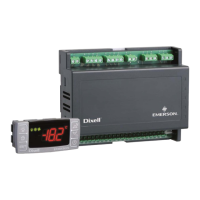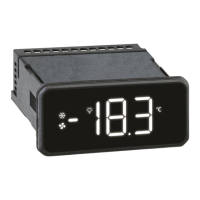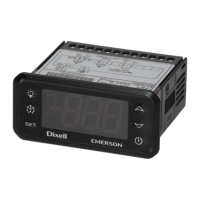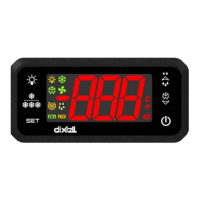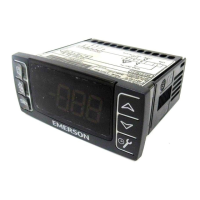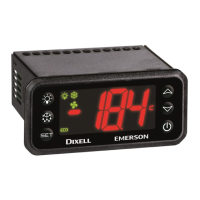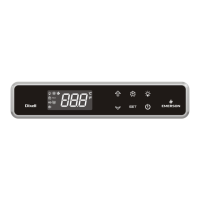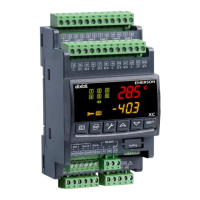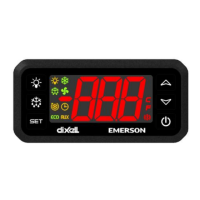1592023020 XM660K_XM669K GB r1.0 07.01.2013.doc XM660K - XM669K 5/8
dAY Current day (Sun ÷ SAt)
Hd1 First weekly holiday (Sun ÷ nu) Set the first day of the week which follows the holiday times.
Hd2 Second weekly holiday (Sun ÷ nu) Set the second day of the week which follows the holiday
times.
Hd3 Third weekly holiday (Sun ÷ nu) Set the third day of the week which follows the holiday times.
ILE Energy Saving cycle start during workdays: (0 ÷ 23h 50 min.) During the Energy Saving
cycle the set point is increased by the value in HES so that the operation set point is SET +
HES.
dLE Energy Saving cycle length during workdays: (0 ÷ 24h 00 min.) Sets the duration of the
Energy Saving cycle on workdays.
ISE Energy Saving cycle start on holidays. (0 ÷ 23h 50 min.)
dSE Energy Saving cycle length on holidays (0 ÷ 24h 00 min.)
HES Temperature increase during the Energy Saving cycle (-30÷30°C / -54÷54°F) sets the
increasing value of the set point during the Energy Saving cycle.
Ld1÷Ld6 Workday defrost start (0 ÷ 23h 50 min.) These parameters set the beginning of the eight
programmable defrost cycles during workdays. Ex. When Ld2 = 12.4 the second defrost starts
at 12.40 during workdays.
Sd1÷Sd6 Holiday defrost start (0 ÷ 23h 50 min.) These parameters set the beginning of the eight
programmable defrost cycles on holidays. Ex. When Sd2 = 3.4 the second defrost starts at 3.40
on holidays.
ENERGY SAVING
ESP Energy saving probe selection: (nP - P1 - P2 - P3 - P4 - P5 – tEr).
HES Temperature increase during the Energy Saving cycle : (-30÷30°C / -54÷54°F) sets the
increasing value of the set point during the Energy Saving cycle.
PEL Energy saving activation when light is switched off: (n÷Y) n= function disabled; Y= energy
saving is actived when the light is switched off and vice versa;
LAN MANAGEMENT
LMd Desfrost synchronisation: y= the section send a command to start defrost to oher controllers,
n= the section don’t send a global defrost command
dEM Type of end defrost: n= the of the LAN defrost are indipendent; y= the end of the defrost are
synchronisated;
LSP L.A.N. set-point synchronisation: y= the section set-point, when modified, is updated to the
same value on all the other sections; n= the set-point value is modified only in the local section
LdS L.A.N. display synchronisation: y= the value displayed by the section is sent to all the other
sections; n= the value displayed by the section is shown only in the local section
LOF L.A.N. On/Off synchronisation this parameter states if the On/Off command of the section will
act on all the other ones too: y= the On/Off command is sent to all the other sections; n= the
On/Off command acts only in the local section
LLi L.A.N. light synchronisation this parameter states if the light command of the section will act
on all the other ones too: y= the light command is sent to all the other sections; n= the light
command acts only in the local section
LES L.A.N. energy saving synchronisation this parameter states if the energy saving command
of the section will act on all the other ones too: y= the Energy Saving command is sent to all the
other sections; n= the Energy Saving command acts only in the local section
LSd Remote probe display: this parameter states if the section has to display the local probe value
or the value coming from another section: y= the displayed value is the one coming from
another section (which has parameter LdS = y); n= the displayed value is the local probe one.
LPP Remote pressure probe: n= the value of pressure probe is read from local probe; Y= the value
of pressure probe is sent via LAN;
StM Solenoid activation via LAN: n= not used; Y= a generic cooling requests from LAN activate
the solenoid valve connected to compressor relay;
PROBE CONFIGURATION
P1C Probe 1 configuration: (nP – Ptc – ntc – PtM) nP= not present; PtC= Ptc; ntc= Ptc; PtM=
Pt1000;
Ot Probe 1 calibration: (-12.0
÷
÷÷
÷
12.0°C/ -21
÷
÷÷
÷
21°F) allows to adjust possible offset of the
thermostat probe.
P2C Probe 2 configuration: (nP – Ptc – ntc – PtM) nP= not present; PtC= Ptc; ntc= Ptc; PtM=
Pt1000;
OE Probe 2 calibration: (-12.0
÷
÷÷
÷
12.0°C/ -21
÷
÷÷
÷
21°F) allows to adjust possible offsets of the
evaporator probe.
P3C Probe 3 configuration: (nP – Ptc – ntc – PtM) nP= not present; PtC= Ptc; ntc= Ptc; PtM=
Pt1000;
o3 Probe 3 calibration: (-12.0
÷
÷÷
÷
12.0°C/ -21
÷
÷÷
÷
21°F) allows to adjust possible offset of the probe 3.
P4C Probe 4 configuration: (nP – Ptc – ntc – PtM) nP= not present; PtC= Ptc; ntc= Ptc; PtM=
Pt1000;
o4 Probe 4 calibration: (-12.0
÷
÷÷
÷
12.0°C/ -21
÷
÷÷
÷
21°F) allows to adjust possible offset of the probe 4.
P5C Probe 5 configuration: (nP – Ptc – ntc – PtM – 420 – 5Vr) nP= not present; PtM= Pt1000;
420= 4÷ 20mA; 5Vr= 0÷5V ratiometric; (Only XM669K)
o5 Probe 5 calibration: (-12.0
÷
÷÷
÷
12.0°C/ -21
÷
÷÷
÷
21°F) allows to adjust possible offset of the probe 5.
(Only XM669K)
P6C Probe 6 configuration: (nP – Ptc – ntc – PtM) nP= not present; PtC= Ptc; ntc= Ptc; PtM=
Pt1000; (Only XM669K)
o6 Probe 6 calibration: (-12.0
÷
÷÷
÷
12.0°C/ -21
÷
÷÷
÷
21°F) allows to adjust possible offset of the probe 6.
(Only XM669K)
SERVICE – READ ONLY
CLt Coling time percentage: it shows the effective cooling time calculated by XM600 during
regulation;
tMd Time to next defrost: it shows time before the next defrost if interval defrost is selected;
LSn L.A.N. section number (1 ÷ 5) Shows the number of sections available in the L.A.N.
Lan L.A.N. serial address (1 ÷ LSn) Identifies the instrument address inside local network of
multiplexed cabinet controller.
Adr RS485 serial address (1÷247): Identifies the instrument address when connected to a
ModBUS compatible monitoring system.
Rel Release software: (read only) Software version of the microprocessor.
Ptb Parameter table: (read only) it shows the original code of the dIXEL parameter map.
Pr2 Access to the protected parameter list (read only).
10. DIGITAL INPUTS
The XM600 series can support up to 2 free of voltage contact configurable digital inputs (depending on
the models). They are configurable via i#F parameter
10.1 GENERIC ALARM (EAL)
As soon as the digital input is activated the unit will wait for “d1d” for d. i. 1 or “d2d” for d. i. 2 time delay
before signalling the “EAL” alarm message. The outputs status don’t change. The alarm stops just after
the digital input is de-activated.
10.2 SERIOUS ALARM MODE (BAL)
When the digital input is activated, the unit will wait for “d1d” for d. i. 1 or “d2d” for d. i. 2 delay before
signalling the “BAL” alarm message. The relay outputs are switched OFF. The alarm will stop as soon
as the digital input is de-activated.
10.3 PRESSURE SWITCH (PAL)
If during the interval time set by “d1d” for d. i. 1 or “d2d” for d. i. 2 parameter, the pressure switch has
reached the number of activation of the “nPS” parameter, the “CA” pressure alarm message will be
displayed. The compressor and the regulation are stopped. When the digital input is ON the compressor
is always OFF. If the nPS activation in the d#d time is reached, switch off and on the instrument
to restart normal regulation.
10.4 DOOR SWITCH INPUT (dor)
It signals the door status and the corresponding relay output status through the “odc” parameter: no =
normal (any change); Fan = Fan OFF; CPr = Compressor OFF; F_C = Compressor and fan OFF. Since
the door is opened, after the delay time set through parameter “d#d”, the door alarm is enabled, the
display shows the message “dA” and the regulation restarts after rrd time. The alarm stops as soon
as the external digital input is disabled again. With the door open, the high and low temperature alarms
are disabled.
10.5 START DEFROST (DEF)
It executes a defrost if there are the right conditions. After the defrost is finished, the normal regulation
will restart only if the digital input is disabled otherwise the instrument will wait until the “Mdf” safety time
is expired.
10.6 RELAY LIGHT ACTUATION (LIG)
This function allows to turn ON and OFF the light relay by using the digital input as external switch.
10.7 REMOTE ON/OFF (ONF)
This function allows to switch ON and OFF the instrument.
10.8 KIND OF ACTION (HTR)
This function allows to change the kind of regulation from cooling to heating and vice versa.
10.9 FHU – NOT USED
This function allows to change the kind of regulation from cooling to heating and viceversa.
10.10 ENERGY SAVING INPUT (ES)
The Energy Saving function allows to change the set point value as the result of the SET+ HES
(parameter) sum. This function is enabled until the digital input is activated.
10.11 CONFIGURABLE INPUT - HOLIDAY FUNCTION (HDY)
In Holiday function Energy saving and defrost cycles follow holiday times. (Sd1…Sd6)
10.12 DIGITAL INPUTS POLARITY
The digital inputs polarity depends on “I#P” parameters: CL : the digital input is activated by closing the
contact; OP : the digital input is activated by opening the contact.
11. INSTALLATION AND MOUNTING
The CX660 keyboard shall be mounted on vertical panel, in a
29x71 mm hole, and fixed using the special bracket supplied. The
temperature range allowed for correct operation is 0÷60 °C. Avoid
places subject to strong vibrations, corrosive gases, excessive dirt
or humidity. The same recommendations apply to probes. Let air
circulate by the cooling holes.
12. ELECTRICAL CONNECTIONS
XM660K/XM669K is provided with screw terminal block to connect cables with a cross section up to 1,6
mm
2
for all the low voltage connection: the RS485, the LAN, the probes, the digital inputs and the
keyboard. Other inputs, power supply and relays connections are provided with Faston connection (5.0
mm). Heat-resistant cables have to be used. Before connecting cables make sure the power supply
complies with the instrument’s requirements. Separate the probe cables from the power supply cables,
from the outputs and the power connections. Do not exceed the maximum current allowed on each
relay, in case of heavier loads use a suitable external relay. N.B. Maximum current allowed for all the
loads is 16A.
12.1 PROBE CONNECTIONS
The probes shall be mounted with the bulb upwards to prevent damages due to casual liquid infiltration.
It is recommended to place the thermostat probe away from air streams to correctly measure the
average room temperature. Place the defrost termination probe among the evaporator fins in the coldest
place, where most ice is formed, far from heaters or from the warmest place during defrost, to prevent
premature defrost termination.

